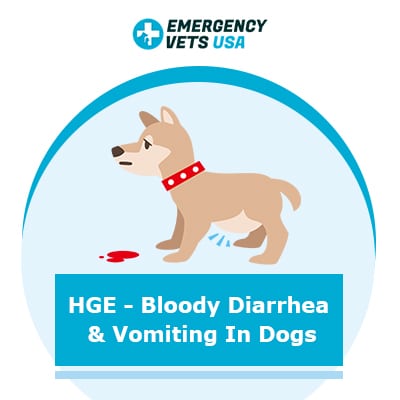HGE – Bloody Diarrhea & Vomiting In Dogs
Understandably, HGE (Hemorrhagic Gastroenteritis) is a condition that causes dog owners quite a fright. The sight of bloody diarrhea or vomiting in your furry friend can cause great concern, and lead you to wonder what could possibly cause it.
In this article we will talk about bloody diarrhea and vomiting in dogs, the possible causes, and what to expect if your dog is diagnosed with HGE.
What is HGE (AHDS)?

Hemorrhagic Gastroenteritis (HGE), or Acute Hemorrhagic Diarrhea Syndrome (AHDS), is an often sudden occurrence of bloody diarrhea or bloody vomiting in dogs. HGE can come on suddenly in otherwise healthy dogs, leading pet owners to wonder the mysterious cause behind their dogs acute illness.
Symptoms Of HGE Or AHDS In Dogs
Though we have already mentioned the main and most startling symptoms of this condition, there are a few other symptoms that your dog may experience with HGE. Each possible symptoms includes:
- Bloody diarrhea
- Bloody vomit
- Diarrhea with clotted blood, often looks like jelly
- Lack of appetite
- Painful abdomen
- Lethargy
- Extreme weakness
What Causes HGE or AHDS In Dogs?
Though HGE or AHDS is extremely common in dogs, the cause of this condition is still unknown. Though The possible causes can range from ingesting fatty foods to experiencing a toxicity, causing even more mystery around this abrupt illness. The most common possible causes of HGE in dogs includes:
- Dietary indiscretion
- Change in diet
- Infectious gastrointestinal disease
- Bacterial overgrowth
- Intestinal parasites
- Foreign body
- Stress
- Trauma
- Clotting disorders
- & more
Though the cause of bloody diarrhea and vomiting in dogs is unknown, there is one thing that each veterinarian understands without a doubt; it needs to be treated immediately.
Treatment Of HGE or AHDS In Dogs
No matter the cause of your dog’s bloody diarrhea and vomiting, it will need to be treated as a medical emergency. Diarrhea and vomiting can dehydrate your canine companion as is, but HGE is even more serious of a situation.
Dogs with HGE or AHDS will often be extremely ill and experiencing severe dehydration, and are in need of aggressive medical care as a result. Bloody diarrhea can be life threatening if left untreated, so it’s important to take this situation seriously if it ever happens to your furry friend.
An ideal treatment for HGE would involve hospitalization with aggressive fluid therapy, IV antibiotics for intestinal upset, along with IV anti-nausea medication to control the vomiting. Though subcutaneous fluids and outpatient care can be an option for these pups as well, it’s not ideal for a situation this severe.
During your dog’s initial treatment, your veterinarian may also begin treatment for any possible causes of your dog’s sudden GI upset. Since there are so many possible factors behind this strange illness, each treatment method will vary from dog to dog.
Recovering From HGE Or AHDS
Due to the sudden and frightening onset of AHDS in dogs, many owners wonder how long it will take for their dog to recover. Though each case will vary based on how sick the dog was when they made it to the vet for treatment, there is a general recovery timeline.
Most dogs with HGE will need to stay in the hospital for at least 24 hours, though sometimes up to 72 hours. The most important part of their recovery is addressing their dehydration, and hopefully eliminating the vomiting all together.
Once your dog is no longer vomiting and can keep oral medications down, they are usually safe to go home and continue their care with you.
Ideally, your dog will not leave the hospital until they no longer have blood in their stool. Though the goal is to eliminate the blood in their stool, your dog will likely experience normal diarrhea for the week to come. It takes time for the gut to recover from this experience, so you can’t expect to see normal stool overnight.
As long as you are diligent about giving your dog their prescription medications and a bland diet while they recover, normal stool will be in their near future. Ideally, you should expect to see their diarrhea improve with each day.
Can You Prevent Bloody Diarrhea and Vomiting In Dogs?
Though HGE can come on suddenly in otherwise healthy dogs, there are some ways that you can help to eliminate any possible risks in your dog’s life. The best ways to prevent HGE or AHDS in dogs includes:
- Do not give your dog any table scraps or fatty food
- Stick to a high quality dog food
- Do not abruptly switch their diet
- Avoid stress whenever possible
- Keep up with your dogs preventative care (vaccines, deworming, etc)
Summary
Though bloody diarrhea and vomiting in your dog can be startling, there is an effective treatment plan as long as you contact your vet as soon as possible. Be sure to review the information we listed above, and your dog will find relief from their HGE in no time.

My name is Amber. I am a dedicated animal lover that turned my passion into my career. I am a Licensed Vet Tech with 12 years of experience in veterinary medicine, but I recently took my career online to help spread accurate information on animal care. With how vast the online world is, I have a strong desire to ensure that the reader always walks away with helpful pet advice. With the experience I’ve gained from my time in this field, I have been able to travel the world, offering my services to as many animal rescues as I can find. If I am not at my laptop, or back home visiting family, you can find me somewhere in the world, cuddling every furry friend that I can find! More About Us
